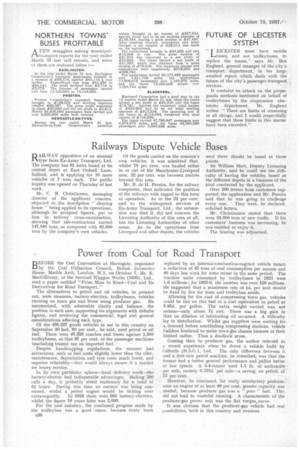Power from Coal for Road Transport
Page 68

If you've noticed an error in this article please click here to report it so we can fix it.
BEFORE the Goal Convention at Harrogate, organized by the Coat Utilisation Council, British Industries House, 'Marble Arch, London, W.1, on October 7, Mr. E. MacGillivray, of the Sentinel Waggon Works (1936), Ltd., read a paper entitled "Foam Mine to Road—Coal and Its Derivatives for Road Transport."
The alternatives to petrol and oil vehicles, he pointed out, were steamers, battery-electrics, trolleybuses, vehicles running on town gas and those using producer gas. He summarized, with admirable clarity and balance, the position in each case, supporting his arguments with definite figures, and reviewing the commercial, legal and general considerations affecting each type.
Of the 459,227 goods vehicles in use in this country on September 30 last, 90 per cent., he said, used petrol or oil fuel. There were 47,528 coaches and buses against 1,588 trolleybuses, so that 97 per cent, of the passenger machines (excluding trams) ran on imported fee!.
Despite handicapping. regulations, the steamer had attractions, such as fuel costs slightly lower than the oiler, maintenance, depreciation and tyre costs much lower, and superior reliability—that would always ensure it a market for heavy service.
In its own partitular sphere—local delivery work—the battery-electric had indisputable advantages. Making 200 calls a day, it probably stood stationary for a. total of 61 hours. During this time no current was being consumed, whilst a petrol engine would be ticking over extravagantly. In 1926 there were 603 battery-electrics, whilst the figure 10 years later was 2,000.
For the coal industry, the continued progress made by the trolleybus was a good omen, because every tram 1350 replaced by an internal-combustion-engined vehicle meant a reduction of 45 tons of coal consumption per annum and 40 days less work for some miner in the same period. The traction units consumed by trolleybuses in 1923 were 1.6 millions for 1935-6, the number was over 100 millions. He suggested that a maximum rate of id. per unit should be fixed by law for train and trolleybus needs.
Allowing for the cost of compressing town gas, vehicles could be run on this fuel at a cost equivalent to petrol at 9.85d. per gallon. The extra weight carried was not serious—only about 7/ cwt. There was a big gain in that no dilution of lubricating oil occurred. A difficulty lay in distribution. Whilst gas suppliers were waiting for a demand before establishing compressing stations, vehicle builders hesitated to make town-as chassis because of their limited radius. Thus a deadlock arose.
Coming then to producer gas, the author referred to a recent experience when he drove a vehicle built by
' (Affords (H.S.G.), Ltd. The only difference between it and a first-rate petrol machine, he remarked, was that the former had a better general performance and pulled better at low speeds. A 3-4-tonner used 1.1 lb. of anthracite per mile, namely 0.255d. per mile—a saving, on petrol, of 73 per cent.
However, he continued, for really satisfactory performance an engine of at least 40 per cent, greater capacity was needed, because producer gas was a " poor " fuel. This did not lead to wasteful running. A characteristic of the producer-gas power unit was the fiat torque, curve.
It was obvious that the producer-gas vehicle had real possibilities, both in this country and overseas.




































































































